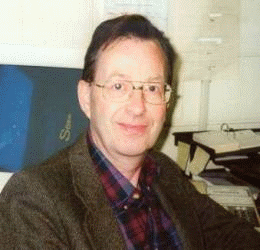In Memoriam Professor George Leibbrandt of the University of Guelph 1937 - 2001
 The Canadian Physics and Mathematics communities suffered a great loss
recently when Professor George Leibbrandt of the University of Guelph suddenly passed
away last April 3, 2001.
The Canadian Physics and Mathematics communities suffered a great loss
recently when Professor George Leibbrandt of the University of Guelph suddenly passed
away last April 3, 2001.
George began his career in Theoretical Physics at McMaster University, obtaining a B.Sc. there in 1961. He then went on to carry out graduate work at McGill University, getting an M.Sc. and then a Ph.D. there, completing his studies in 1967. Shortly before the defense of his thesis, he took up a position in the Department of Mathematics and Statistics at the University of Guelph in 1966, a position he retained until his death in 2001.
George enjoyed a long, productive and stimulating career in theoretical physics. He actively participated in the life of both the mathematics and physics departments at the University of Guelph, and was a well-known and much admired figure in each. Throughout his career, he supervised 10 postdoctoral fellows and 8 graduate students. He enjoyed the collegiality of his fellow researchers in theoretical physics throughout Southern Ontario, and participated regularly in the activities of the Guelph-Waterloo Physics Institute and in special events held at Toronto, Western, and McMaster.
His expertise in theoretical physics took him to some of the most prestigious institutions around the world, including Imperial College, Cambridge University, CERN, Harvard, and the ICTP in Trieste. He won two Humboldt Fellowships and was twice a Bye Fellow at Cambridge.
George's expertise was in gauge field theories. He was one of the first people to apply dimensional regularization to perturbative loop corrections in quantum gravity. The technique -- which involves calculating divergent integrals by analytically continuing in the number of spacetime dimensions -- was still quite new at the time, and George became one of the first experts on its application to quantum field theory.
In the 1980s George moved on to study field theories in non-covariant gauges. All standard model interactions respect the principle of gauge invariance, which allows for a redefinition of the 4-vector potential associate with a force according to a certain prescription. The simplest example is the modification of the vector potential in electromagnetism by the addition of the gradient of an arbitrary function; if you add such a gradient to the vector potential, both the electric and magnetic fields remain unchanged. In order to calculate in a quantum gauge field theory, it is necessary to "fix the gauge" ie choose a particular form of constraint on the gauge field (eg the photon or gluon) which eliminates the redundant gradient terms. In the 1970s this was almost always done covariantly, ie. in a manner that manifestly respected Lorentz invariance. However, while physical observations cannot depend on this choice of constraint, little was known about how to carry out calculations when the constaint was chosen non-covariantly.
George was one of the pioneers in demonstrating how to carry out quantum field theoretic corrections for this case, in a context which came to be referred to as a "non-covariant gauge" choice. His prescription for treating these cases came to be known as the "Mandlestam-Leibbrandt" prescription, named after both George and Stanly Mandlestam, who also worked on this subject. The techniques they developed became essential in demonstrating the finiteness of certain field theories such as N=4 Supersymmetric Yang-Mills theories.
In 1999 George was asked to become a founding member of the Perimeter Institute for Theoretical Physics, a task to which he dedicated himself wholeheartedly. He worked closely with the principal donor, Mike Lazaridis, and with Howard Burton, its executive director. George was very concerned that the Institute fulfil its mandate to be a premier place for research in theoretical physics, and he spent many volunteer hours attending board meetings, going through architectural plans, and participating in discussions concerning its scientific merit.
George will always be remembered for his kindness and patience. Always ready to help out a student or colleague in need, he had a way of providing encouragement just when you needed it most. His modesty concerning his own accomplishments in physics did not do justice to their importance. He will be sorely missed.
Dr. Robert Mann, University of Waterloo